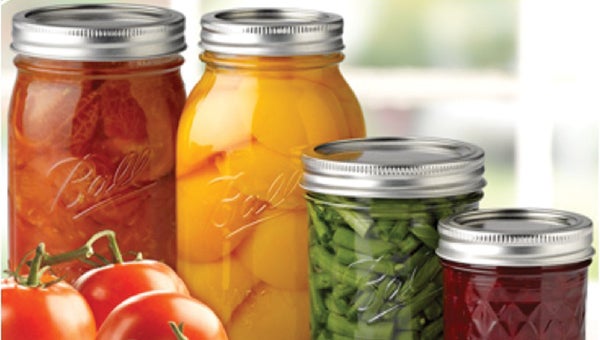
By Janice Hall
Growing and preserving your own food lets you enjoy delicious, in-season fruits and vegetables throughout the year.
For many of us who may not have our very own home garden, there is still a way we can capture the great quality and flavor of fresh fruits and vegetables and indulge in them all year.
Fruit and vegetable growers offer a wide variety of fresh fruits and vegetables; notably corn, squash, okra, greens and of course those sweet watermelons during the summer months at local farmers’ markets and roadside stands.
If you are thinking about canning as a way to preserve your food this summer, there are a couple of things you should have in place before getting started.
Recipes
All home canned foods should be prepared using research tested recipes.
Research is done continually to provide the latest, most up-to-date recommendations.
Many new guidelines have been released over the last couple of years, so make sure your recipes have the latest information to keep your family safe.
The Extension office in your county will be able to provide you with this information.
Equipment
Review the equipment needed for canning and make sure they are ready in advance. A water bath canner is needed for processing fruits, pickles and jams and jellies.
A large pressure canner is essential for vegetables, meats, fish and other low-acid foods.
You should also have a sharp knife, jars, measuring cups, new lids, a funnel, sugar, salt, rings and a jar lifter.
Check your jars for chipping and check gaskets for damage. Be aware that you can call your county Extension office to request a day that you wish to have your dial gauge canner lid tested. Weighted gauges do not need to be tested.
While there, pick up a Home Food Preservation order request form. This book is the only reference and recipe book of its kind published in Alabama.
Home Food Preservation includes information on canning, freezing, drying, jams, jellies, pickles, relishes and other combination foods. It is based on the most recent USDA guidelines.
Canning process
The canning process should begin as each fruit or vegetable is being harvested.
For a nicer product, try to use fruit or vegetables without any sign of insect damage, bruising or wilting.
The first step will be to sterilize your jars. As you prepare your recipe, get your canner on the stove.
Next, fill your jars according to the directions and then seal. Step-by-step instructions on how to use a pressure canner are available at your county Extension office.
After removing them from the canner, put them onto a dry, clean cloth where they can sit for the next 24 hours.
The following morning, you should check to make sure you get a good seal. If you do, put them up and enjoy this winter.
A jar lid that puckers when pressed would indicate a lid that did not seal. At this point, you will need to reprocess within 24 hours using new lids.
Also, be aware that you can also freeze, dry and pickle your fruits and vegetables.
Publications on how to do so can be found at www.aces.edu, or contact your local Extension office.
Storage
You want to make sure that you have a good storage area; after all, you’ve put in a lot of work.
Most canned food items are good for up to a year.
For a complete list, you may download an Extension publication called “Better Safe than Sorry Food Storage Chart,” or request one from your county Extension office. There are many other publications available for home food preservers at www.aces.edu.
You may also visit the University of Georgia website for more information at
www.uga.edu/nchfp/.
Finally, we have completed the rewarding job of canning our fresh fruits and vegetables.
There is nothing left to do now but sit back and enjoy!
Here is a great recipe from the Home Food Preservation book that you can try:
Corn Relish
(Recipe makes about 9 pints.)
16 to 20 ears of corn
5 cups white vinegar
2 1/2 cups diced sweet red peppers
2 1/2 tablespoons pickling salt
2 1/2 cups diced green bell peppers
2 1/2 teaspoons celery seed
2 1/2 cups chopped celery
2 1/2 tablespoons dry mustard
1 1/4 cups chopped onion
1 1/4 teaspoons turmeric
1 3/4 cups sugar
Use medium-size ears of corn. Remove husks, wash corn and remove silks. Hot pack: Place corn in a large pot of boiling water and boil five minutes. Then, dip the ears in cold water and cut kernels from cob. Prepare enough to make 10 cups of kernels. Combine red and green peppers, celery, onion, sugar, vinegar, salt and celery seed in a large pot. Bring to a boil, reduce heat and simmer five minutes, stirring occasionally. Dip out 1/2 cup of the simmered mixture and add mustard and turmeric. Mix well. Then, return this mixture to the pot and add corn. Simmer another five minutes. If desired, thicken mixture with flour paste (1/4 cup flour blended in 1/4 cup water) and stir frequently. Fill hot jars with relish, leaving a 1/2-inch headspace. Remove air bubbles. Wipe jar rims and adjust the lids.
Process in a boiling water bath canner (half-pints or pints, 15 minutes).
Note: You can use six 10-ounce packages of frozen corn in place of fresh corn.
For more recipe ideas, contact the Chilton County Extension Office at (205) 280-6268.
Janice Hall is a Regional Extension Agent in Food Safety, Preparation and Preservation for Alabama Cooperative Extension.
